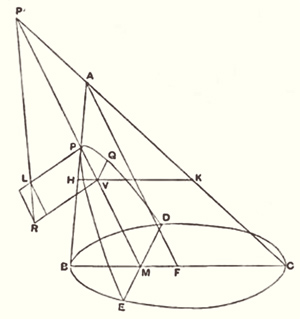A Touch of Etymology
The cone definition we've been discussing owes to the Conics of Apollonius of Perga (c.262 BC – c.190 BC). Apparently he was the one who coined the words ellipse, parabola, and hyperbola, whose origin is as follows.
Recall that the latus rectum is the length r of the focal chord perpendicular to the axis. Consider any point on the conic.  Let y be its perpendicular distance from the axis, and x the distance from the foot of the perpendicular to the vertex. Apollonius showed that Let y be its perpendicular distance from the axis, and x the distance from the foot of the perpendicular to the vertex. Apollonius showed that
y2 = r ⋅ x + (ε2 – 1) x2
The focus-and-directrix property wasn't known at the time, so his formulation of this equation was slightly different, and of course involved rectangles rather than a simple product of numbers. But the two are essentially the
same.
Now, if the conic is a hyperbola, then ε > 1 and y2 > r ⋅ x. We therefore say that y2 exceeds or goes beyond (υπϵρβαλλϵι) the value r ⋅ x. This is the same root as that of the word hyperbole, which refers to exaggeration as a figure of speech. The sayings of Christ contain many famous examples, e.g.: "If your eye sins against you, pluck it out."
Next, if the conic is a parabola, then ε = 1 and y2 = r ⋅ x, so y2 can be applied (παραβαλλϵιν) to r ⋅ x. The same root appears in the word parable, a
tale that explains a principle by way of application. Well-known examples include the parables of the Good Samaritan and the Prodigal Son.
Finally, if the conic is an ellipse, then ε < 1 and y2 < r ⋅ x. It follows that y2 falls
short of (ϵλλϵιπϵι) the value r ⋅ x. Other words with the same root include elliptical (referring to speech that leaves something unsaid) and the term for the punctuation mark … , which is called an ellipsis. In language, ellipsis is the omission of a word or phrase which would ordinarily be required by the rest of the sentence, e.g.: "My brother can play the zither and my sister [can play] the dulcimer."
Next: Parabolas and Artillery |

